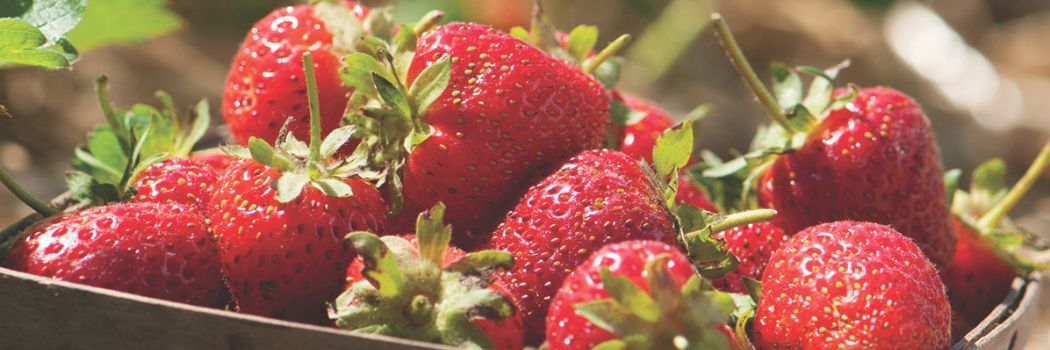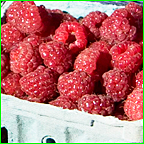by Lynn Byczynski
Protecting Your Investment
High tunnels have proliferated in recent times, and there is no question that they can be profitable for vegetable crops. University researchers also have been analyzing small fruit production in high tunnels and, not surprisingly, finding many benefits.
For berry growers, some of the advantages of protected culture include keeping foliage and fruit dry and thus less likely to suffer from disease; the ability to exclude birds, rabbits, and other wildlife that love berries; the ability to prevent weeds among the fruits; protection from hail, wind, and hard rains; cleaner berries; and a more comfortable picking environment. In many studies, high-tunnel crops had much higher yields than field crops. And the longer season afforded by high tunnels meant significantly higher prices for out-of-season fruits.
If these sound like good reasons to grow berries in a high tunnel, read on. We'll summarize some of the pertinent research, point you to some great resources, and maybe help you determine whether fruit could be a profitable part of your crop mix.
Raspberries & Blackberries in Protected Culture
Brambles are among the most popular fruit crops for protected culture. In California, the #2 state behind Washington for raspberry production, the vast majority are grown under plastic. While precise data on acreage are scarce, according to USDA estimates, more than 4000 acres of raspberries are grown under protected cover in the Golden State.
In the Northeast, local raspberries grown outside are typically available from mid-June to early October. A typical field crop of everbearing raspberries may be harvested for 5 weeks until the first hard frost, but if grown under a tunnel that is covered with plastic in late summer, it may be harvested for 10 weeks or longer. By growing both summer-fruiting floricane varieties and fall-fruiting primocane varieties, some in high tunnels and some in the field, growers can have raspberries from May through November. Prices are better both early and late in the season, and getting into the market earlier can help a grower win the loyalty of customers who buy all season long.
According to experts at Cornell University, primocane-bearing raspberries managed in the high tunnel for a single fall crop (that is, mowed down after bearing or in early spring) typically yield more than three times as much as field crops. Researchers attribute the increase to reduced gray mold, a longer picking season, closer spacing in the tunnel, "and possibly other reasons." See the comprehensive manual, updated in 2012, High Tunnel Raspberries and Blackberries.
In Southwest Michigan trials with four summer-fruiting and four fall-fruiting cultivars, tunnel-grown yields were greater than twice those of field-grown plants. In addition, tunnel-grown raspberries were 20–40% larger than those from the field. The two best summer-bearing varieties ('Encore' and 'Nova') yielded no fruit the year of planting (as would be expected with biennial canes); 2200 lb/acre in year 2; and 19,200 lb/acre in years 3 and 4. The best fall-fruiting cultivars averaged 2600 lb/acre the initial year and 18,600 lb/acre each year over the next two years. The researchers calculated net annual profits from summer raspberries of $6750/acre, and net annual profit from fall raspberries of $31,000/acre. For more information, see Economics of High Tunnel Raspberry Production.
In Pennsylvania, research on new thornless blackberries demonstrated very high marketable yields in the tunnels. This is good news because winter injury has historically resulted in a lack of blackberry production in the field. Additional breeding advances have brought us new varieties such as 'Prime-Ark Freedom' from Arkansas, bred expressly for flowering and fruiting on first-year canes, and exceptionally large, exceptionally early, flavorful berries in abundance. Further specifics on the economics and cultural advantages are detailed in Small Fruit Production in High Tunnels.
Strawberries in Protected Culture
Unlike in-ground production of brambles, which occupy space year-round, high-tunnel strawberries can be grown in an annual system. Strawberry plugs are planted in early fall (i.e., September in North America) and fruit the following spring. When production starts to diminish, the plants can be removed so that the high tunnel space can be used for a summer crop.
Research at the University of Missouri on the annual strawberry system found that harvest started 4 weeks ahead of field strawberries and continued for 2 months. And 95% of the berries were marketable, compared to only 60% of those grown outside. Berries were sold at a produce auction for up to $6/qt, with the price averaging $4.40/qt ($3.67/lb). According to the economic analysis, a yield of 1.25 lb/plant and a selling price of $3.50/lb would return a net of $1800/1000 sq ft. Read Growing Strawberries in High Tunnels in Missouri for more information.
Strawberry plasticulture is supplanting the traditional matted row system on many farms. This involves planting on black plastic mulch from mid-July to September, protecting the plants from cold damage, and harvesting the fruit the following spring. Some form of winter protection is required where temperatures fall below 12°F (-11°C). Although hay and straw are the traditional mulching materials, many strawberry growers use row covers because they require less labor to install and remove. Heavier row covers, weighing 1.25 oz./sq.yd. or more, are recommended.
In Pennsylvania, research on strawberry production in a plasticulture system using short-day or day-neutral cultivars showed it to be viable. The researchers concluded, however, that the primary benefit of high tunnels for strawberry cultivation may have been reliability of production rather than a yield increase.
Blueberries in Protected Culture
Less research has been conducted on growing blueberries under plastic. The main benefits identified to date are protection from birds and frost. In fact, a study in Florida showed enormous potential savings to Southern blueberry growers. The study tracked two growing seasons on a commercial (highbush) blueberry farm. During the study period, temperatures plunged to freezing or near-freezing more than 60 times outside, but only three times inside the unheated tunnels. The tunnels also protected the plants from wind and rain damage, leading to better flowering and more fruit. Plants grown in the tunnels produced about 4.5 tons of ripe fruit per acre by the end of March, when prices are highest, whereas no ripe fruit came from similar plants grown outdoors during that time.
Read more about the specifics of the Florida research in High Tunnels Yield Better Blueberries.
Undercover Fruit Production — An Attractive Prospect
While research on protected fruit cultivation is still emergent, its findings are promising and being validated by growers on the land. If you find the possibilities compelling, then give them consideration, take a closer look, follow through on best preparatory measures, and try your hand. The rewards could be considerable.
Byczynski and her family have been growing vegetables and cut flowers since 1988, selling through CSAs, at farmers' markets, to chefs, grocery stores, and florists. They currently grow cut flowers and hoophouse tomatoes on about 2 acres of their 20-acre farm near Lawrence, Kansas.
She is also the author/editor of two of our favorite books about market farming, The Flower Farmer and The Hoophouse Handbook.






